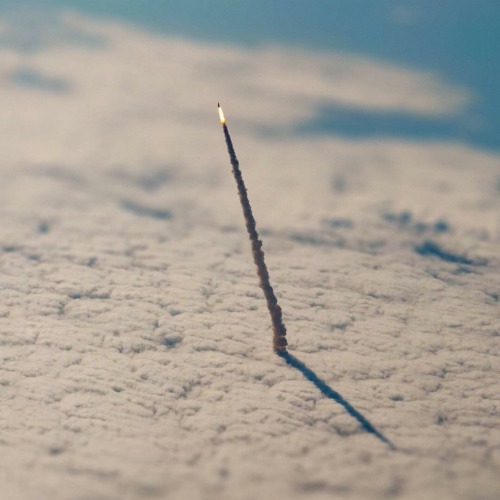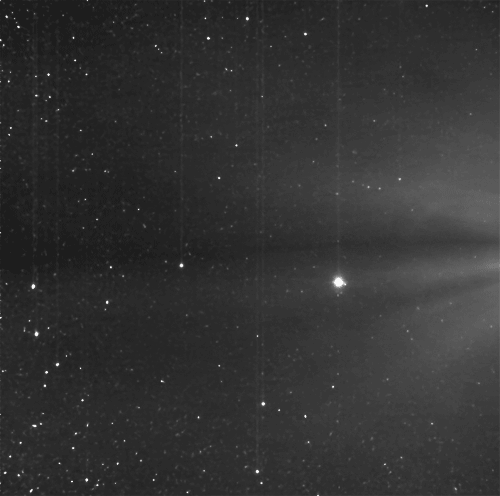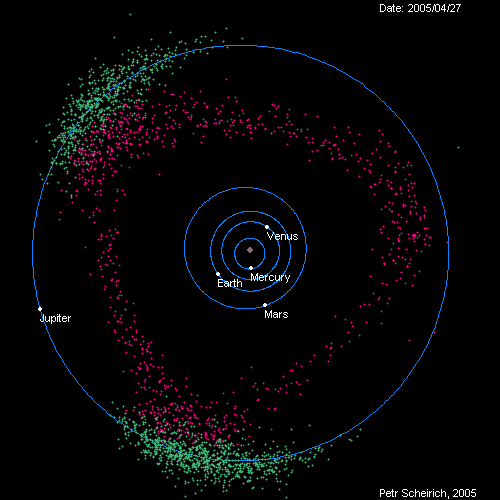Michael Benson


Michael Benson
1. Mimas Above Saturn’s Rings and Shadows, Cassini, November, 7, 2004
2. Mimas Transits Saturn’s Ring Shadows, Cassini, January 18, 2005
More Posts from Xnzda and Others

Tilt-shift photo of the space shuttle Endeavour by NASA
https://www.nasa.gov/mission_pages/shuttle/flyout/multimedia/endeavour/11-05-16-2.html

stars, mercury, and solar corona, photographed by stereo a, january 2009.
27 frames, photographed over 36 hours, 2nd-3rd january. the sun is out of frame right.
image credit: nasa/stereo. animation: ageofdestruction.

The orbit of Jupiter protects the Earth from asteroids.

The Egg Nebula
The Egg Nebula is approximately 3,000 Light years away from Earth.Resembling a rippling pool illuminated by underwater lights, the Egg Nebula offers astronomers a special look at the normally invisible dust shells swaddling an aging star. These dust layers, extending over one-tenth of a light-year from the star, have an onionskin structure that forms concentric rings around the star.
Image credit: NASA

A cosmic blossom
IC 5148 is a beautiful planetary nebula located some 3000 light-years away in the constellation of Grus (The Crane). The nebula has a diameter of a couple of light-years, and it is still growing at over 50 kilometres per second — one of the fastest expanding planetary nebulae known. The term “planetary nebula” arose in the 19th century, when the first observations of such objects — through the small telescopes available at the time — looked somewhat like giant planets. Although the name stuck, it represents the expanding shell of gas ejected from old red giant stars late in their lives.
And now this one resembles a lovely blossom with layered petals.
Credit: European Southern Observatory
-
 dotglobal liked this · 6 months ago
dotglobal liked this · 6 months ago -
 naelune liked this · 6 months ago
naelune liked this · 6 months ago -
 onanightofwintryfog reblogged this · 2 years ago
onanightofwintryfog reblogged this · 2 years ago -
 tes-situra reblogged this · 3 years ago
tes-situra reblogged this · 3 years ago -
 avadaniels reblogged this · 3 years ago
avadaniels reblogged this · 3 years ago -
 herfilm reblogged this · 3 years ago
herfilm reblogged this · 3 years ago -
 lionelaton liked this · 3 years ago
lionelaton liked this · 3 years ago -
 bribrieye liked this · 3 years ago
bribrieye liked this · 3 years ago -
 space-movements reblogged this · 3 years ago
space-movements reblogged this · 3 years ago -
 madmaxmaddison reblogged this · 3 years ago
madmaxmaddison reblogged this · 3 years ago -
 valdier reblogged this · 3 years ago
valdier reblogged this · 3 years ago -
 trivia-love reblogged this · 3 years ago
trivia-love reblogged this · 3 years ago -
 fourlatn reblogged this · 3 years ago
fourlatn reblogged this · 3 years ago -
 mintaropeach liked this · 3 years ago
mintaropeach liked this · 3 years ago -
 sneep-snarp reblogged this · 3 years ago
sneep-snarp reblogged this · 3 years ago -
 hclark70 liked this · 3 years ago
hclark70 liked this · 3 years ago -
 ghostsinthecellar reblogged this · 3 years ago
ghostsinthecellar reblogged this · 3 years ago -
 n7cmmndr liked this · 3 years ago
n7cmmndr liked this · 3 years ago -
 otgw reblogged this · 3 years ago
otgw reblogged this · 3 years ago -
 octoberings reblogged this · 3 years ago
octoberings reblogged this · 3 years ago -
 purplezebras150 liked this · 3 years ago
purplezebras150 liked this · 3 years ago -
 timetravellingghost liked this · 3 years ago
timetravellingghost liked this · 3 years ago -
 cowsintuxedos reblogged this · 3 years ago
cowsintuxedos reblogged this · 3 years ago -
 cowsintuxedos liked this · 3 years ago
cowsintuxedos liked this · 3 years ago -
 razzleberriesss liked this · 3 years ago
razzleberriesss liked this · 3 years ago -
 lumortal liked this · 3 years ago
lumortal liked this · 3 years ago -
 8xs liked this · 3 years ago
8xs liked this · 3 years ago -
 titlecard reblogged this · 3 years ago
titlecard reblogged this · 3 years ago -
 wanderingthot reblogged this · 3 years ago
wanderingthot reblogged this · 3 years ago -
 claringtonrps reblogged this · 3 years ago
claringtonrps reblogged this · 3 years ago -
 prometheis reblogged this · 3 years ago
prometheis reblogged this · 3 years ago -
 stardating reblogged this · 4 years ago
stardating reblogged this · 4 years ago -
 setonfire13 liked this · 4 years ago
setonfire13 liked this · 4 years ago -
 my-broken-timemachine reblogged this · 4 years ago
my-broken-timemachine reblogged this · 4 years ago -
 darlingavasilva reblogged this · 4 years ago
darlingavasilva reblogged this · 4 years ago -
 zamuo reblogged this · 4 years ago
zamuo reblogged this · 4 years ago -
 onanightofwintryfog liked this · 4 years ago
onanightofwintryfog liked this · 4 years ago -
 idlepulse reblogged this · 4 years ago
idlepulse reblogged this · 4 years ago -
 mikroklima reblogged this · 5 years ago
mikroklima reblogged this · 5 years ago -
 neslepaks reblogged this · 5 years ago
neslepaks reblogged this · 5 years ago




